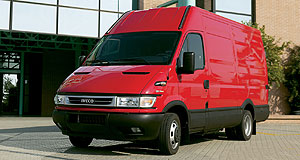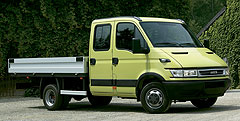Iveco delivers better Daily bread
BY JOHN WRIGHT | 13th Apr 2005

Starting to roll out later this month, the 2005 models boast major mechanical upgrades and a revised radiator grille.
But the most symbolic change is to the interior, which gets user-friendlier soft-touch materials for the steering wheel and dashboard. The gauges and controls look familiar but the higher level of trim materials is immediately evident.
So there’s more butter on the Daily bread, prices of which are still to be announced but should start in the high-$30,000s.
If you think of the heavy-duty rear-drive Daily as being the point at which light commercial vans meet light trucks, you can see why the change of trim is so significant.
How seriously Iveco has approached the business of building a high level of comfort and equipment into the Daily is perhaps best illustrated by a list of standard items shown in a slide during the press conference – remote central locking, electric windows, heated electric mirrors and cruise control.
They had not even bothered to mention that automatic climate control is also standard on all models.
Model nomenclature requires unraveling. There are ‘S’ and ‘C’ variants with different engines, payloads and bodies. ‘S’ stands for Single rear wheels and ‘C’ for dual rear wheels. S models get a new 2.3-litre diesel engine, while C models in Van, Single Cab and Dual Cab variants and GVMs up to 6.5 tonnes get the 3.0-litre engine, which is among the torquiest four-cylinder engines on the market.
Both units feature common-rail fuel injection capable of injection pressures of up to 1800 bar, along with dual overhead camshafts and four valves per cylinder.
The 2.3 HPI (high pressure injection) engine makes 100kW of power and 320Nm of torque, while the 3.0-litre HPI engine HPI version produces 100kW and 340Nm. A 123lW/380Nm 3.0 HPT (high pressure turbocharger) unit may come later.
The 2.3 models get a five-speed manual gearbox and the 3.0 models have an extra ratio. In the fourth quarter of 2005, Iveco Australia will offer automated transmissions with no clutch pedal.
Overall noise levels have been improved dramatically. The claims are about half as much noise at top speed and just a third at idle.
Iveco has made more than four million light commercial diesel engines and the experience shows. There were no 2.3-litre Dailys available for us to drive at the vehicle’s launch last week, but three of the bigger-engined models (two Vans and a Cab-Chassis) showed their immense torque, impressive refinement and comfort, and good dynamics.
A load of two tonnes felt barely more than one, which in turn felt much like being unladen. The useful green zone on the tachometer emphasises the long torque plateau.

Built on a 3950 mm wheelbase, it measures 7012 mm in total length and will swallow a 17.2 cubic metre load. The 5.0 tonne van accepts 12.0.
Rear air suspension is optional at $2310.
A division of the Fiat Group, Iveco is far from being a household name in the van market and many passenger car buyers may not have heard of the company, which was formed in 1972, effectively replacing Fiat as a maker of trucks.
There has been a culture change at Iveco, which has traditionally been a heavy-duty truck manufacturer but is now anxious to sell vehicles in large quantities to the light and medium commercial sectors. The Daily’s rivals include the Mercedes-Benz Sprinter, Renault Master and Fiat Ducato.
Apart from the slightly more decorative grille and much-improved interior trim, the new Daily may look like the Yesterdaily but is effectively an all-new vehicle, with class-leading diesel engines and superior transmissions.